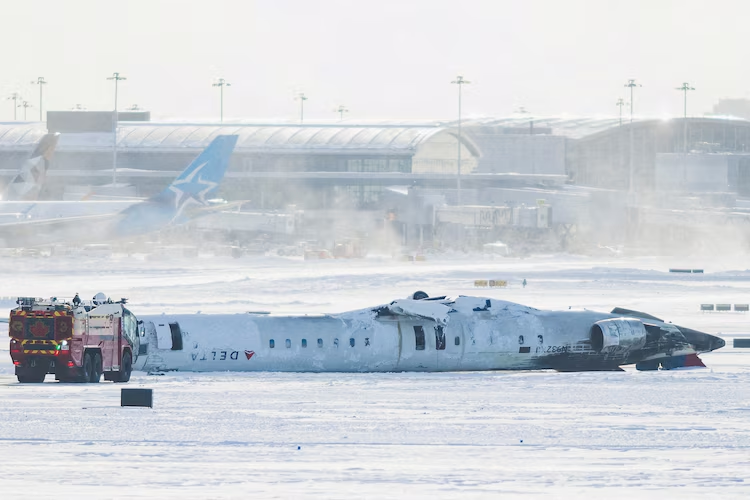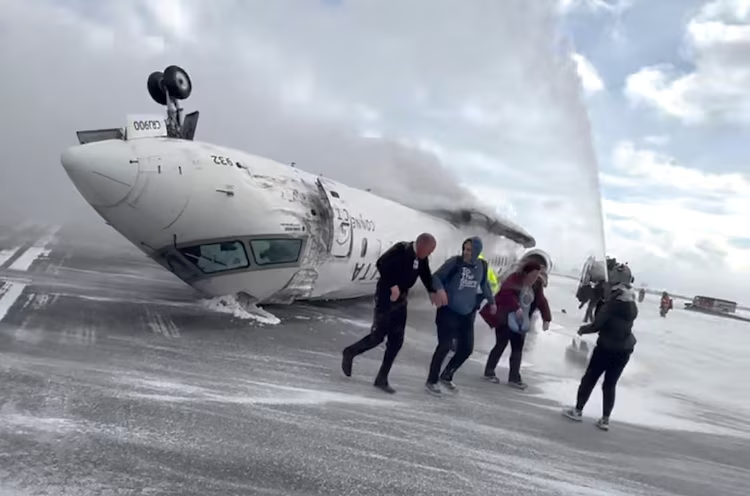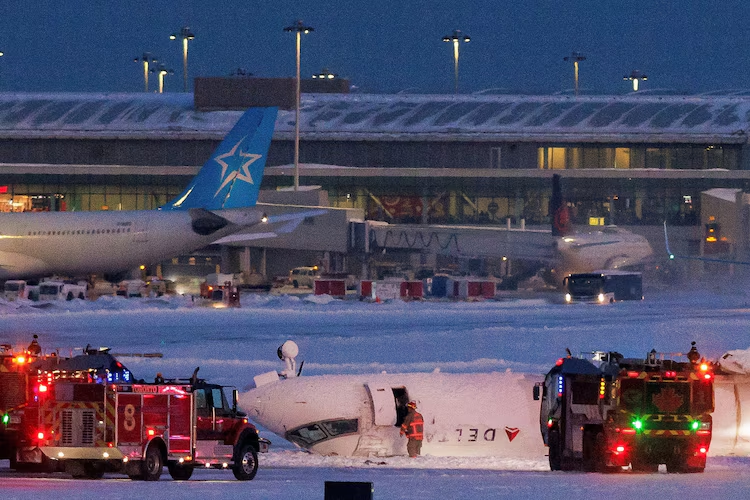A Delta Air Lines jet with 80 people on board crash-landed at Toronto Pearson International Airport. This happened around 2:15 p.m. ET on Monday. The crash sent 21 people to the hospital, with many emergency teams rushing to help.
Thankfully, no one died in the crash. But, three people, including a child, are in critical but not life-threatening condition.

Key Takeaways
- The crash occurred at around 2:15 p.m. ET on Monday.
- A total of 80 people were aboard Delta Connection Flight 4819.
- 21 passengers were initially transported to local hospitals.
- Only three individuals remain hospitalized as of Tuesday morning.
- No fatalities have been reported in this incident.
Details of the Toronto Plane Crash Incident
The recent plane crash in Toronto has caught a lot of attention. It happened during severe weather. A Delta Flight 4819, flying from Minneapolis-St. Paul to Toronto, crash-landed at Toronto Pearson International Airport at about 2:15 p.m. The plane, a CRJ-900, was operated by Endeavor Air. The crash caused big problems at the airport, affecting flights and passengers.
Flight Information
Delta Flight 4819 had 76 passengers and 4 crew members. It faced bad weather, including snow and strong winds, during landing. The crash happened at 2:15 p.m. and stopped flights at Toronto Pearson International Airport.
Wind speeds were up to 40 mph, making landing hard.
Aircraft Details
The Bombardier *CRJ-900* was involved in the accident. It’s known for being tough and has been flying for over 20 years. It’s made to handle hard landings well.
But, in this crash, the plane flipped and lost its right wing. It caught fire and came to rest about 650 feet from where it landed. Despite the danger, most people were quickly taken out.
Emergency services quickly responded to the crash. They made sure everyone was safe and the situation was under control.
| Details | Information |
|---|---|
| Flight Number | Delta Flight 4819 |
| Aircraft Model | Bombardier CRJ-900 |
| Passengers & Crew | 80 (76 passengers, 4 crew) |
| Injuries | 21 injured, with 3 critical injuries |
| Weather Conditions | Blowing snow, 40 mph wind gusts |
| Impact | Loss of right wing, caught fire |
| Runways Affected | Two runways closed |
Survivors and Injuries
The recent incident in Toronto involved 80 people on a plane. This included 76 passengers and 4 crew members. Thankfully, no one died, but 21 people got hurt.
Number of Passengers and Crew
There were 80 people on the plane that had the bad luck. This number is made up of 76 passengers and 4 crew members. Among the passengers, 22 were from Canada, and 58 were from other countries.
Medical Response
The medical team responded quickly to the crash. They helped 21 injured people get to hospitals fast. Reports say they worked hard to help those who needed it most.
By Tuesday morning, 19 of the injured were already home. This shows how well the medical team worked.
Current Status of Injured
Now, three people are still in the hospital. They are a child, a man in his 60s, and a woman in her 40s. They are okay, but need more care.
The fast and skilled medical help has been key. It has helped these injured people a lot.
Statements from Delta Air Lines
Delta Air Lines has spoken out after a sad event at Toronto Pearson International Airport. The accident happened around 2:15 p.m. ET on February 17, 2025. It has caught a lot of attention and the airline is quick to help the victims.
Official Press Release
CEO Ed Bastian of Delta Air Lines has shown deep concern. “Our thoughts and prayers are with everyone on Delta flight 4819 and their families,” he said. He also promised to help passengers get medical care and support during their recovery.
Support for Victims
Delta Air Lines is fully supporting the victims of the plane crash. They are providing medical help, emotional support, and help with daily tasks for the families. The airline is also running more flights to help with the travel disruptions.
| Aspect | Details |
|---|---|
| Time of Incident | 2:15 p.m. ET |
| Resumption of Operations | 5 p.m. ET |
| Total People Onboard | 80 (76 passengers, 4 crew members) |
| Total Injured | 18 |
| Critical Injuries | 3 |
| Support Offered By Delta Air Lines | Medical care, additional flights, logistic support |
Eyewitness Accounts from Passengers
After the Toronto plane crash, many passengers shared their scary stories. Peter Carlson, a healthcare worker, told of the plane flipping over when it landed. He said it was very bad weather.
People were hanging from their seatbelts, making things even more chaotic. This added to the fear inside the plane.

Personal Narratives
Peter Carlson and John Nelson talked about how everyone worked together. They helped each other get out of the plane, even with strong winds. Over 18 people went to the hospital.
Twelve had minor injuries, and three were very badly hurt. Many felt very stressed and scared after the crash.
Video Footage
Video footage from the crash showed the evacuation. It was very clear and showed how fast the responders came. The videos showed how everyone stayed calm and helped each other.
This footage is very important. It shows how lucky everyone was to not get hurt worse. The stories and videos together give a clear picture of what happened.
Weather Conditions During the Crash
When the Toronto plane crash happened, the weather was very bad. There were strong winds and lots of snow. These things might have made the crash worse.
Meteorological Data
The plane faced tough weather with winds up to 40 mph. It was very cold, at 16.5 degrees Fahrenheit. Before the crash, there was a lot of snow, more than all winter.
This made the runway slippery. It was “Code 555,” meaning it was wet and snowy.
Impact on Flight Operations
The bad weather really affected flights at Toronto Pearson International Airport. The winds were too strong for safe landings.
Over 8 inches of snow fell before the crash. This made takeoffs and landings very hard. The extreme weather made the crash more likely.
| Flight Data Points | Details |
|---|---|
| Total number of people on board | 80 |
| Passengers transported to hospitals | 21 |
| Wind Speed at Time of Crash | 32 mph |
| Maximum Wind Gusts | 40 mph |
| Temperature | 16.5°F |
| Snow Accumulation | More than all of last winter |
| Runway Condition Classification | Code 555 |
Details of the Initial Inspection
The first look at the crash site in Toronto after Delta Flight 4819’s accident has found key details. Teams from the Transportation Safety Board of Canada worked hard to collect evidence. They looked at the plane’s debris, where it hit, and the state of important parts.

Early findings from the first look at the crash in Toronto show important points. Investigators are checking the crash site’s evidence, like the plane’s position and damage. They also look at the flight controls and engines.
They will also study the black boxes. These record flight data and what was said in the cockpit. This will help a lot in the investigation.
The plane was a CRJ 900 from Endeavor Air, known for being reliable. But, the bad weather was also a big factor. Wind speeds were up to 40 mph, and it was snowing.
Investigators are looking into how these weather conditions affected the crash. They want to know if they played a part in what happened.
The first look at the crash in Toronto shows it’s a complex case. Many things are being checked, like human choices and how the plane worked. They are also looking at safety rules and emergency actions. This will help them understand the whole situation.
Comparison with Recent Aviation Accidents
The crash of Delta Air Lines Flight 4819 at Toronto Pearson is part of a worrying trend. In less than a month, North America has seen three major air crashes. This shows we need to check our aviation safety very carefully.
North American Incidents
Flight DL4819’s crash, where 80 people survived but 18 were hurt, is the fourth big accident in three weeks. On January 29, 2024, a plane and a military helicopter crashed near Washington D.C., killing 67. Then, a medical plane crashed in Philadelphia on February 1, 2024, killing seven, including a child.
Just after, a small plane crashed in Alaska on February 6, 2024, killing ten. These crashes show we need to look at our safety rules again. The US National Transportation Safety Board says there were 257 fatal accidents worldwide in 2024. This is down from 362 in 2014, showing safety is getting better. But, we must act fast to keep passengers safe.
Historic Crashes at Toronto Pearson
Toronto Pearson has seen many crashes, like the Air France Flight 358 in August 2005. The plane went off the runway during a storm and caught fire. Luckily, no one died in the crash. This shows how important it is to learn from past accidents to make flying safer.
The recent and past crashes at Toronto Pearson show the same problems. The strong winds during the Delta crash show how weather can affect flying. Studying these accidents will help us make flying safer for everyone.
Role of First Responders
First responders played a huge role in the Toronto plane crash. Paramedics, firefighters, and police were quick to arrive. They showed their skill and speed in emergency situations.
Emergency Services Involved
Teams from Toronto Fire Services, Peel Regional Paramedic Services, and Toronto Police Service were there. They helped get all 80 people off the plane safely. Their fast work made the rescue a success.

Actions Taken During the Rescue
When they got there, the responders quickly figured out what to do. Firefighters put out fires and got people out of the plane. Paramedics gave medical help to the 18 hurt people.
Three of the most hurt were taken to the hospital by Ornge. Their fast and organized work helped a lot. They made sure everyone got the care they needed.
Ongoing Investigation
The ongoing investigation into the Toronto plane crash is being done by the Transportation Safety Board of Canada. They are looking at the flight data, weather, and the plane’s condition. Their goal is to find out why the crash happened and how to avoid it in the future.
Experts are studying the plane’s last moments and the wing breaking off. They also look at the 40 miles per hour wind gusts during landing. The CRJ-900 aircraft, flying for Delta Air Lines, faced strong turbulence.
They will compare this crash with others in Washington D.C., Philadelphia, and Alaska. This will help find common causes or special factors. The results will help make flying safer in the future.
“This is a rare occurrence,” said an aviation expert with over 30,000 flight hours. He talked about the plane flipping upside down during landing.”
All 80 people on Delta Flight 4819 survived, which is amazing. Here’s a quick look at how everyone is doing:
| Parameter | Details |
|---|---|
| Total Passengers and Crew | 80 |
| Survivors | 100% |
| Injured Passengers | 18 |
| Critical Condition | 2 (1 adult, 1 child) |
The investigation into the ongoing investigation Toronto plane crash is very important. It will help prevent future plane crashes.
Conclusion
This article covers the Toronto plane crash from start to finish. Delta Flight 4819 crashed at Toronto Pearson International Airport. It left 21 people hurt, including a child who is now recovering well.
The plane flipped after landing. This happened because of over a foot of snow and strong winds. The weather was very bad, with winds up to 40 miles per hour.
Weather is key in keeping flights safe. The crash happened when winds were 51 km/h, with gusts up to 65 km/h. Both Canadian and US authorities are working together to learn from this crash.
Two runways at Toronto Pearson will be closed for a while. This is to help with the investigation. They want to learn as much as they can from this crash.
The crash showed how strong people can be. Survivors and responders showed great strength. Emergency services acted fast, showing how well airports respond in emergencies.
As the investigation goes on, the industry will learn a lot. They will work to make flying safer. They want to avoid crashes like this in the future.
FAQ
What details are available about the Toronto plane crash?
The Toronto plane crash details include flight and aircraft info. It also talks about passengers and crew, medical responses, and the injured’s status.
How many people were on board, and what is their status?
The section on survivors and injuries has the passenger and crew numbers. It also talks about their health and the medical response.
What has Delta Air Lines said about the incident?
Delta Air Lines has released a statement about the crash. They are supporting the victims and their families. More info is in the section on Delta Air Lines’ statements.
Have any eyewitnesses provided accounts of the crash?
Yes, passengers have shared their stories and video footage. Their accounts give a firsthand look at the accident.
What were the weather conditions like during the crash?
The weather at the time of the crash is discussed in a section. It includes meteorological data and how weather affected flight operations.
What did the initial inspection reveal?
The initial inspection findings are detailed in a section. It includes any early discoveries.
How does this crash compare to other recent aviation accidents?
A comparison with other North American incidents and Toronto Pearson Airport crashes is in a section. It looks at recent aviation accidents.
What role did first responders play in the rescue efforts?
The section on first responders talks about their role. It details the emergency services and their actions during the rescue.
What is the current status of the investigation into the crash?
The investigation’s current status is discussed in a section. It includes updates and findings.

